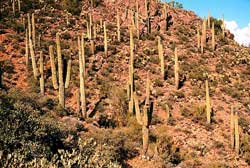Resource Library
Plant of the Week: Saguaro Cactus
The University of Arkansas System Division of Agriculture does not promote, support or recommend plants featured in "Plant of the Week." Please consult your local Extension office for plants suitable for your region.
Plant of the Week
Saguaro Cactus
Latin: (Carnegiea gigantea)

On the top shelf in my little hobby greenhouse grows a giant. Though this giant is only 5 years old and, for now at least, 4 inches tall, it has the potential to get much larger. The plant is the saguaro cactus from the Sonoran Desert of Arizona.
The saguaro cactus (Carnegiea gigantea) is a superstar amongst the cactus family both for its storied existence and size. It can reach as much as 45 feet in height though 20 to 30 feet specimens with foot thick trunks are more common. During the first 75 years of its life, it grows as an unbranched column; thereafter it begins to branch and forms the familiar shape we know. Saguaros often live to be 150 years old.
This cactus grows only in the Sonoran Desert, the driest desert in the United States that occupies 120,000 square miles of the southwestern quarter of Arizona, and adjacent areas in California, the state of Sonora in Mexico and parts of the Baja Peninsula. It occurs in areas receiving between 2 and 10 inches of rainfall per year but won’t grow in salty soils or along arroyos where floods might occur. While it tolerates frost it won’t survive where freezing conditions prevail.
Saguaro stems have 20 or more ribs armed with clusters of stout thorns. The pleated arrangement of the cactus body allows it to expand when rainfall is plentiful and shrink during dry spells. In the spring the ends of the branches wear a topknot of showy white flowers. Flowering begins when plants reach about 50 years of age.
The name saguaro is a Spanish language adaptation of the name used by the Tohono O’odham tribe that inhabited the region prior to European settlement. The Latin name honors Andrew Carnegie, the steel magnate and philanthropist who provided funds for so many libraries around the nation in the early years of the 20th century.
Saguaro was described in 1848 as Cereus giganteus by St. Louis botanist George Englemann, but the cacti specialists from the New York Botanical Garden - Britton and Rose - reclassified it in 1908. Carnegie, who was funding much of their research, was invited to Tucson for the big announcement but lost interest quickly when he was informed it was only a name change, not a new kind of cactus.
Saguaros, for all their size and toughness, live a fragile existence. As with all plants in fragile environments, humans are their biggest threat. Because they are so slow growing and they occur in such remote areas theft is a major concern. Arizona has enacted laws preventing collection from public lands and requires an extensive paper trail to follow all wild-collected saguaros. In an attempt to cut down on cactus rustling, RFD chips have been implanted to aid in the tracking operation.
Though they live a precarious existence sometimes they strike back to extract revenge for mistreatment. Cactus plugging - a highly illegal but still common practice of pumping a cactus body full of lead by armed and drunken marauders - usually results in a dead cactus. But in February of 1982, David Grundman arrived with his shotgun for a bit of merriment but left in a hearse.
Though this incident sounds like an urban legend, especially after the Austin Lounge Lizards immortalized it in their song, "Saguaro," it really happened. Apparently Grundman blasted most of the way through the trunk of a 125-year-old cactus, but it refused to fall. So, to speed things along he took a saguaro rib from a dead plant and poked at one of its giant arms. The 500-pound arm detached and fell on the hapless gunman. Then the main trunk, made unstable by the loss of one of its arms, also toppled, falling directly on top of Grundman and as the Lizards tell us "smashed him like a bug."
Saguaro seeds are produced in abundance and are readily available. Though it is easy to grow from seed, cultivation only marginally speeds its slow growth rate. The best way to enjoy these beauties is to see them in their native habitat where they can be seen in their full grandeur.
By: Gerald Klingaman, retired
Extension Horticulturist - Ornamentals
Extension News - December 12, 2008
The University of Arkansas System Division of Agriculture does not maintain lists of retail outlets where these plants can be purchased. Please check your local nursery or other retail outlets to ask about the availability of these plants for your growing area.